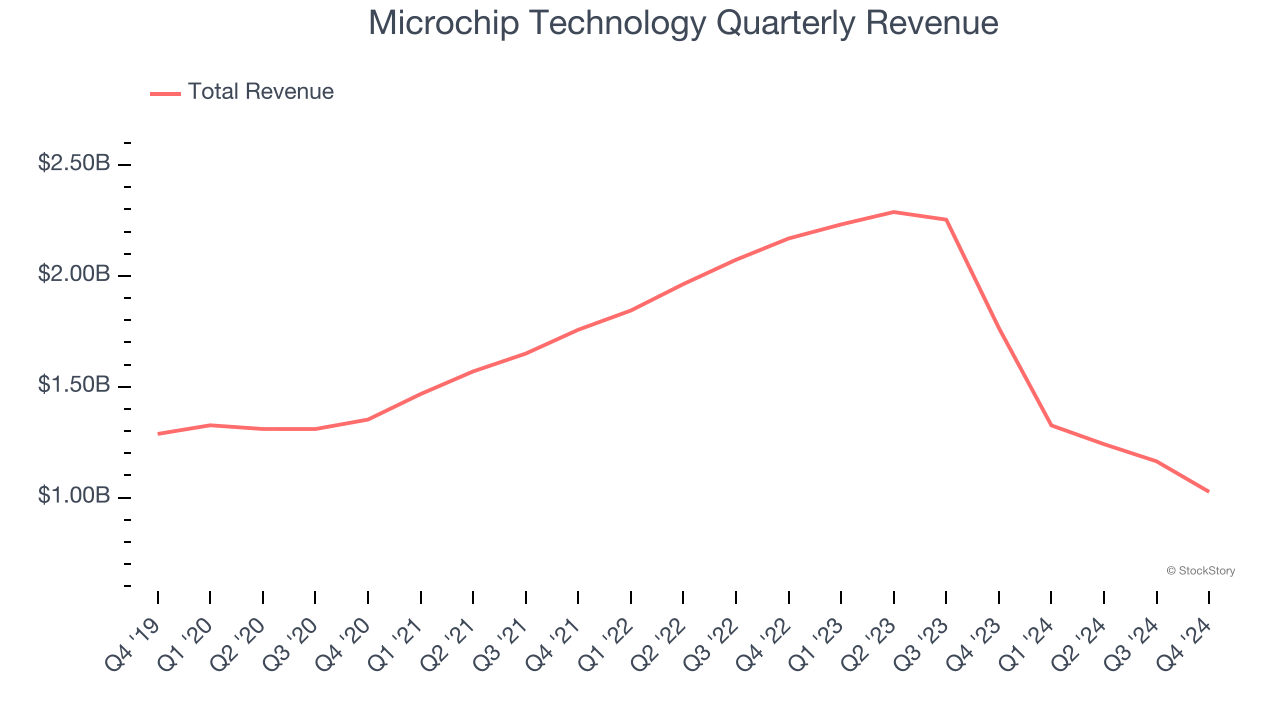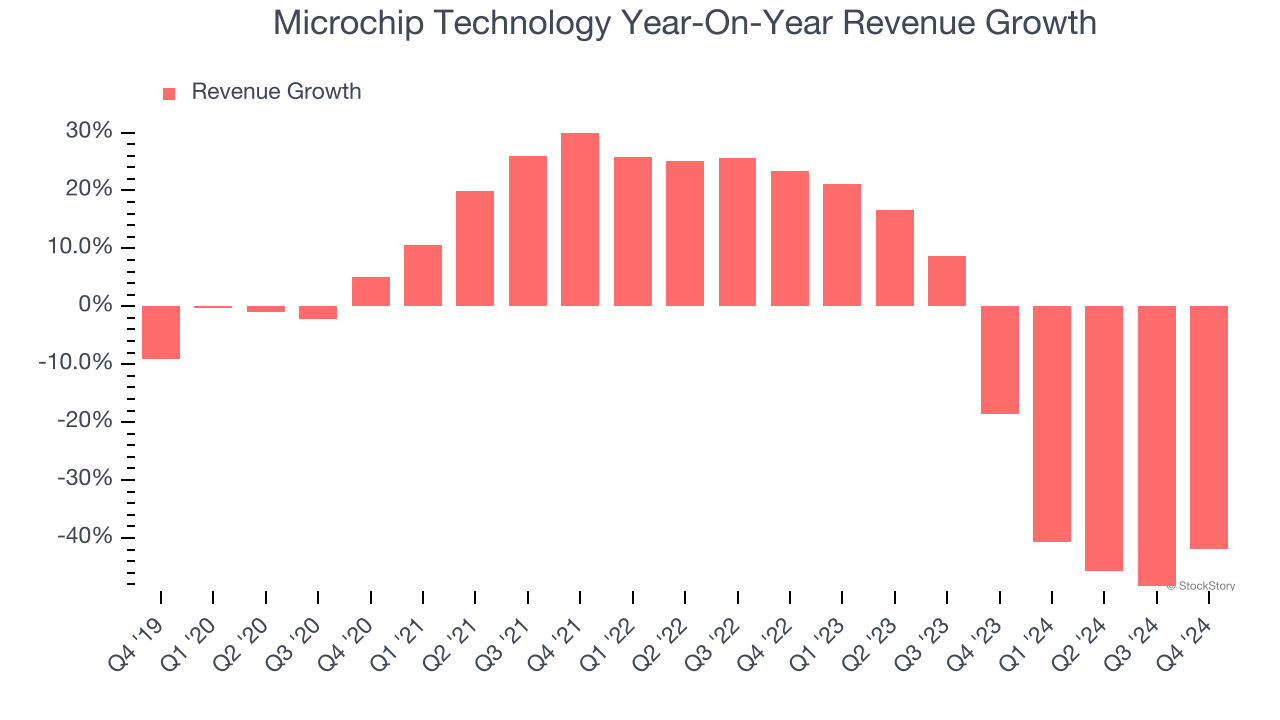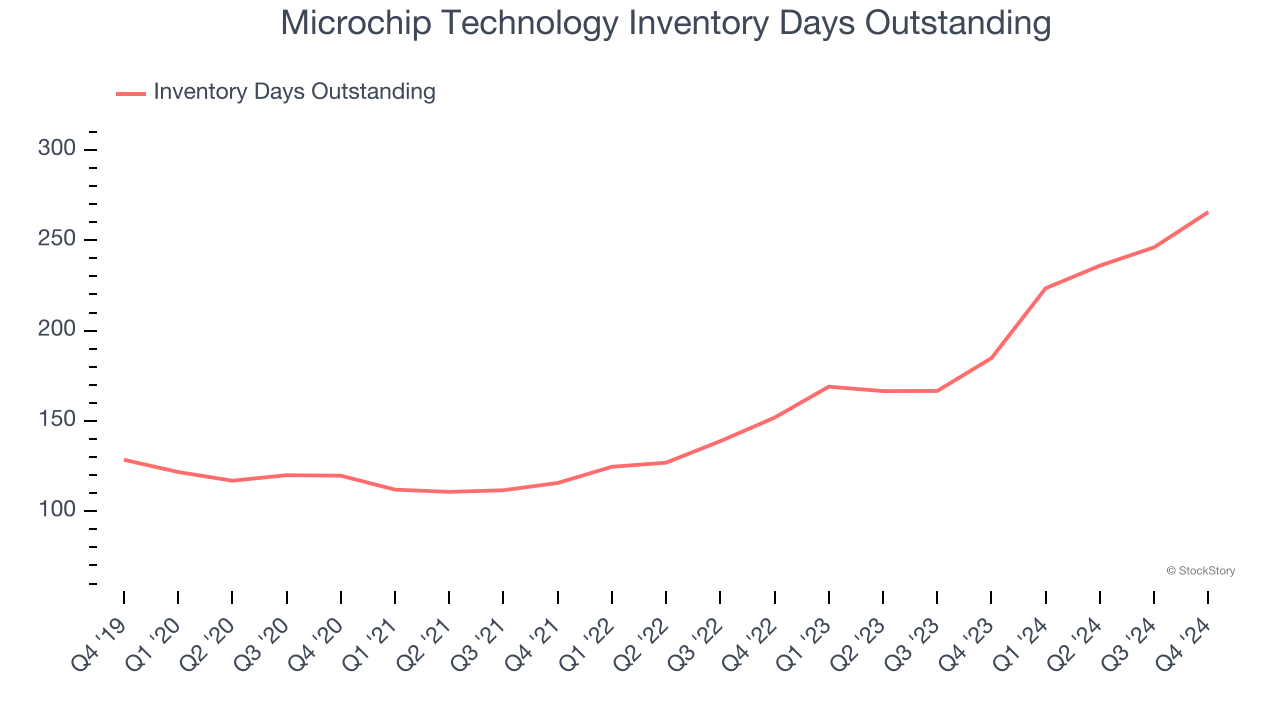
Analog chipmaker Microchip Technology (NASDAQ:MCHP) missed Wall Street’s revenue expectations in Q4 CY2024, with sales falling 41.9% year on year to $1.03 billion. Next quarter’s revenue guidance of $960 million underwhelmed, coming in 9.2% below analysts’ estimates. Its non-GAAP profit of $0.20 per share was 28.8% below analysts’ consensus estimates.
Is now the time to buy Microchip Technology? Find out by accessing our full research report, it’s free.
Microchip Technology (MCHP) Q4 CY2024 Highlights:
- Revenue: $1.03 billion vs analyst estimates of $1.07 billion (41.9% year-on-year decline, 3.9% miss)
- Adjusted EPS: $0.20 vs analyst expectations of $0.28 (28.8% miss)
- Adjusted Operating Income: $210.7 million vs analyst estimates of $242.9 million (20.5% margin, 13.3% miss)
- Revenue Guidance for Q1 CY2025 is $960 million at the midpoint, below analyst estimates of $1.06 billion
- Adjusted EPS guidance for Q1 CY2025 is $0.10 at the midpoint, below analyst estimates of $0.27
- Operating Margin: 3%, down from 30% in the same quarter last year
- Free Cash Flow Margin: 24.7%, down from 45% in the same quarter last year
- Inventory Days Outstanding: 266, up from 246 in the previous quarter
- Market Capitalization: $28.73 billion
"Our December quarter performance reflects the need for the decisive steps we are taking to realign our business, as revenue declined to $1.026 billion and inventory levels reached 266 days," said Steve Sanghi, Microchip's CEO and President.
Company Overview
Spun out from General Instrument in 1987, Microchip Technology (NASDAQ: MCHP) is a leading provider of microcontrollers and integrated circuits used mainly in the automotive world, especially in electric vehicles and their charging devices.
Analog Semiconductors
Demand for analog chips is generally linked to the overall level of economic growth, as analog chips serve as the building blocks of most electronic goods and equipment. Unlike digital chip designers, analog chip makers tend to produce the majority of their own chips, as analog chip production does not require expensive leading edge nodes. Less dependent on major secular growth drivers, analog product cycles are much longer, often 5-7 years.
Sales Growth
Reviewing a company’s long-term sales performance reveals insights into its quality. Any business can have short-term success, but a top-tier one grows for years. Microchip Technology’s demand was weak over the last five years as its sales fell at a 2.1% annual rate. This was below our standards and is a sign of poor business quality. Semiconductors are a cyclical industry, and long-term investors should be prepared for periods of high growth followed by periods of revenue contractions.

We at StockStory place the most emphasis on long-term growth, but within semiconductors, a half-decade historical view may miss new demand cycles or industry trends like AI. Microchip Technology’s recent history shows its demand has stayed suppressed as its revenue has declined by 23.1% annually over the last two years. 
This quarter, Microchip Technology missed Wall Street’s estimates and reported a rather uninspiring 41.9% year-on-year revenue decline, generating $1.03 billion of revenue. Company management is currently guiding for a 27.6% year-on-year decline in sales next quarter.
Looking further ahead, sell-side analysts expect revenue to remain flat over the next 12 months. While this projection suggests its newer products and services will catalyze better top-line performance, it is still below the sector average.
Here at StockStory, we certainly understand the potential of thematic investing. Diverse winners from Microsoft (MSFT) to Alphabet (GOOG), Coca-Cola (KO) to Monster Beverage (MNST) could all have been identified as promising growth stories with a megatrend driving the growth. So, in that spirit, we’ve identified a relatively under-the-radar profitable growth stock benefiting from the rise of AI, available to you FREE via this link.
Product Demand & Outstanding Inventory
Days Inventory Outstanding (DIO) is an important metric for chipmakers, as it reflects a business’ capital intensity and the cyclical nature of semiconductor supply and demand. In a tight supply environment, inventories tend to be stable, allowing chipmakers to exert pricing power. Steadily increasing DIO can be a warning sign that demand is weak, and if inventories continue to rise, the company may have to downsize production.
This quarter, Microchip Technology’s DIO came in at 266, which is 109 days above its five-year average, suggesting that the company’s inventory has grown to higher levels than we’ve seen in the past.

Key Takeaways from Microchip Technology’s Q4 Results
We struggled to find many positives in these results. Its revenue guidance for next quarter missed significantly and its revenue fell short of Wall Street’s estimates. Overall, this was a softer quarter. The stock traded down 4.9% to $50.50 immediately following the results.
Microchip Technology’s latest earnings report disappointed. One quarter doesn’t define a company’s quality, so let’s explore whether the stock is a buy at the current price. We think that the latest quarter is only one piece of the longer-term business quality puzzle. Quality, when combined with valuation, can help determine if the stock is a buy. We cover that in our actionable full research report which you can read here, it’s free.

